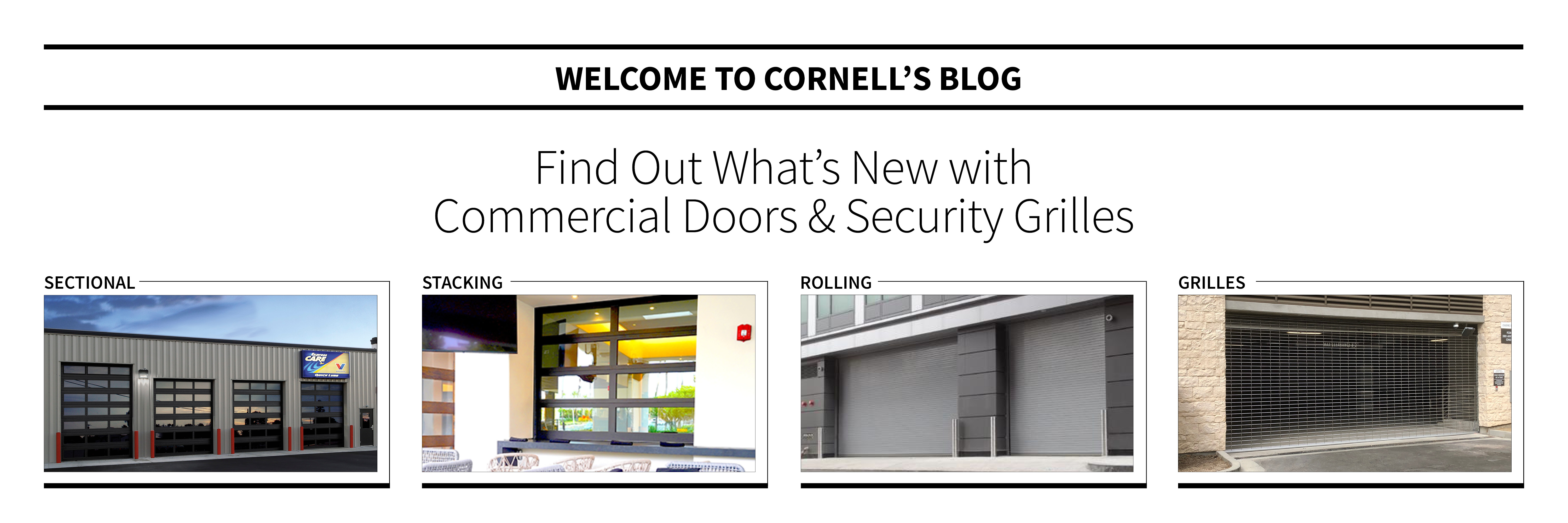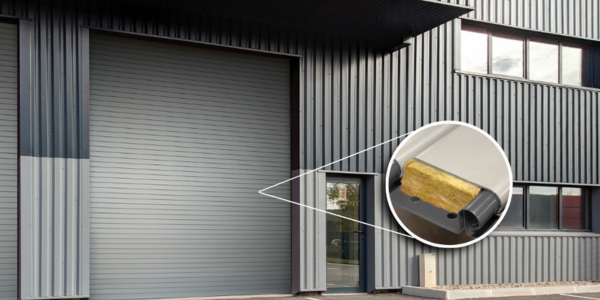

Cornell Commercial Rolling Doors and Security Grilles Blog
When it comes to Overhead Rolling Doors and Grilles, we are the experts in innovative door solutions!
Subscribe
Get updates on new blog posts to your inbox!
Building a Climate-Controlled Garage
When designing and constructing a new building, the goal is to cut costs, not add them. But, as you know, some things are worth investing extra money in — especially if they increase the life span of your building. Building a climate-controlled garage may involve additional costs but is worth it in the long run.
Designing and building with a climate-controlled garage requires many elements, including a high-quality insulated rolling garage door. If you are trying to determine how to control the temperature in a garage, keep reading!

Why Climate Control Is Important
Commercial garages have a lot of uses, ranging from storage to workshops, to carwashes and to showrooms and dealerships. Maintaining a consistent indoor environment benefits your whole building by keeping the environment comfortable for worker's, reducing energy bills, and protecting stored items and equipment.
Cold climates can affect items stored in the garage, such as paints, lubricants, electronics, and wooden furniture. Extreme cold weather can also damage a garage door and concrete garage floors. Concrete floors are especially at risk because concrete shrinks and expands when exposed to extreme fluctuations in temperature. Cars continually driving on top of the concrete can worsen the damage.
Extreme hot temperatures pose different damage, largely having to do with UV rays. UV rays can penetrate the garage and cause paint and epoxy coatings to fade. Hot outdoor temperatures can also increase the garage temperature. Higher temps make HVAC systems work harder to cool your home or business, which in turn, leads to higher energy bills.
Also, if you are building in an area where there is extreme humidity, the foundation of the garage can be put at risk. Over time, excess moisture breaks down a garage's foundation, compromising its integrity. A more short-term problem is mold and mildew. Mold and mildew grow in moist conditions, which often damages the structure, reduces air quality, and can lead to unpleasant odors.
With these elements posing such a major threat to a building and the equipment and tools inside, how can you design a garage to withstand temperature fluctuations?
The answer is simple: garage climate control.
A climate-controlled garage offers resistance to extreme temperatures and fluctuations, securing your client's investment with promising durability and optimal performance.
How to Control the Temperature in Your Garage
To protect a new garage against extreme temperatures, follow these four steps:
1. Install Insulation
As you design and build a new garage, make sure you insulate it well. It's a common misconception that insulation is only helpful in the winter, but insulation is just as important during the summer months. In addition to keeping cold air out in the winter, insulation keeps hot air out in the summer.
When building a new garage, install insulation around all of the areas where air can enter or exit the garage, including the ceiling, walls, doors, and windows. Insulating a garage will help control temperature and humidity.
2. Install Heating and Cooling Systems
Now that you have taken steps to keep intense temperatures out of your newly designed garage, it is time to regulate the temperature inside the garage. The easiest way to do this is by installing a heating and cooling unit.
Here is a list of some possible units you can choose from:
- Electric heaters: These space heaters are more cost-effective than installing a central heating system, although they often take longer to heat a larger space than central units.
- Vented combustion heaters: These heaters use outside air for combustion. In the process of bringing outside air in, they separate unhealthy exhaust gas from indoor air, ensuring that occupants will not breathe in unclean air.
- Window air conditioner: Window air conditioners are beneficial because they give users control over the garage's temperature. In addition, depending on the unit, users may be able to use it as a heater in the winter, too.
- Portable air conditioners: These cooling units are portable, so they can be moved to different parts of a garage.
3. Install Dehumidifiers
In addition to the outside causes of humidity in a garage, heating and cooling systems can bring extra humidity into the space. To fix these moisture issues, you can install a dehumidifier that will lessen the humidity in the garage and allow for more air circulation, preventing the growth of mold and mildew.
4. Install the Right Garage Door
Garage doors play a significant role in controlling the temperature of your garage. When choosing a garage door, you should select a door with reliable, high-performing insulation. This can ensure the temperature in your garage stays stable despite the temperature outdoors.
Why You Should Invest in an Insulated Garage Door
When designing and selecting materials for a building, it's important that you also choose the right garage door.
But is investing in a climate-controlled garage door really worth the money? Consider the following benefits of insulated garage doors for temperature control.
Energy Efficiency
Because a garage is not technically a living space, it's held to different construction standards than other rooms. Compared to other spaces, garages are allowed to have more gaps and air leakage. These lowered construction standards make the garage one of the least energy-efficient areas in a building.
Garages can affect the entire building's temperature. If a garage is left uninsulated, its extreme heat or cold temperatures may drift into the rest of the building, making the building harder and more expensive to heat and cool.
When you opt for an insulated door, the temperature in your garage will be easier to regulate. By regulating the temperature of the garage, less extreme heat or extreme cold will drift into the building, saving the owner money. The building's HVAC system won't have to work as hard to heat or cool the structure.
Durability
Insulated doors are made differently than uninsulated, single-layer garage doors. Garage door frames are typically made from aluminum or steel. Garage door manufacturers fill the frame with insulation, and then the frame is surrounded by panels, usually made of steel. This construction method causes the doors to be lightweight, energy-efficient and less likely to dent than older, single-layer doors.
Overall, opting for an insulated door increases the life span of the garage door. Its increased durability protects it against drastic changes in temperature and day-to-day strains.
When it comes to commercial settings, doors may have to open and close frequently or may be more likely to get bumped by equipment. Insulated garage doors are more likely to hold up to this daily wear and tear than single-layer garage doors, making them a better option.
Noise Reduction
While it may not be the top factor when choosing a garage door, insulated doors dampen noises better than uninsulated doors. Most insulated doors carry an Sound Transmission Class (STC) rating which tells you how sound proof your door will be. Insulated doors have better sound attenuation due to insulation materials and robust perimeter seals.
Convenience
Openings in garages are major areas of energy loss. Traditionally, these openings are pretty large and difficult to insulate. And, that's where an insulated rolling door comes in. To curb the energy loss, you'll need to close air gaps. Insulated doors are intentionally made with energy efficiency in mind, so they come with perimeter seals that stop air leakage. Because of a well-insulated design, they also carry low u-factors. So, your garage door essentially becomes another insulated wall.
RELATED: Understanding Insulated Rolling Doors: A Comprehensive Guide
Considerations for Choosing the Right Insulated Garage Door
If choosing the right garage door is important when creating a climate-controlled garage, how do you know which door to choose?
Manufacturers use various energy efficiency ratings to label garage doors. In addition to these ratings, other materials can affect how energy-efficient a garage door is. To help you find the right garage door for your new building, here are a few factors to keep an eye on.
Garage Door Materials
Commercial garage doors are typically available in steel or aluminum. Of the two, steel offers better insulation. Steel has a lower thermal conductivity, meaning that it resists the transfer of heat. As far as insulation, you'll find a few options there, too. For commercial rolling doors, insulation is typically polyurethane or melamine, or, in extremely energy-efficient models, you'll find mineral wool.
Most modern garage doors are usually made of the following materials:
- Steel: On its own, steel is not an excellent insulator. However, insulated steel doors provide plenty of benefits. Steel is the most common material for garage doors because of its design versatility, durability and low maintenance requirements.
- Aluminum: A lightweight and modern alternative to steel, aluminum garage doors tend to resist moisture and rust, making them ideal for garages in humid climates.
- Wood: Wood is a solid natural insulator. Wood is often chosen to give a building a classy, traditional appearance. However, wood garage doors are susceptible to rot and are extremely heavy, and regular maintenance is necessary to keep the door in good condition, which some clients may not be willing to do.
- Vinyl: These garage doors are beneficial because they are easy to install and able to stand up to many weather conditions. They are also very cost-effective.
R-Value and U-Factor
When it comes to rating the energy efficiency of insulated doors, there are two ratings used: R-value and U-factor. As you look at various insulated doors, you will notice that R-values — also seen as R-ratings — are widely used. But, the use of R-value to determine the thermal efficiency of building products is shifting. Commercial doors are now being rated with U-factor.The reasoning behind this is that the R-value is appropriate for static, uncomplicated architectural components like walls. Commercial applications often need to meet higher thermal efficiency standards. In response, manufacturers use U-factor to give builders and designers a more accurate measure for the dynamic, multi-component designs of rolling doors.
U-factor is the most accurate measure of the energy efficiency of a rolling door, and of any non-static building material. U-factor represents the flow of heat through a material. To get the U-factor, a rolling door is put through rigorous third-party testing in a lab. A lower U-factor represents a more energy-efficient garage door.
Other Factors to Consider
Here are some more factors to consider when choosing and designing an insulated garage door for your client's property:
- Windows: While windows look nice on garage doors, they are not always energy-efficient. Glass and acrylic windows allow heat to escape. If you are designing a garage in a cold environment, consider a garage door with no windows or energy-efficient windows to stabilize the garage's temperature.
- Proper fit: Proper installation is key when using a garage door to control garage door climate. If there are gaps around or underneath a garage door, the insulation will be less effective. To make sure the insulated door can effectively keep heat in, consider having weatherstripping installed around the door.
- Hardware: While it may be surprising, installing high-quality hardware can save energy. Investing in a door that has a high-quality track, frame and rollers will prevent air leakage and gaps.





